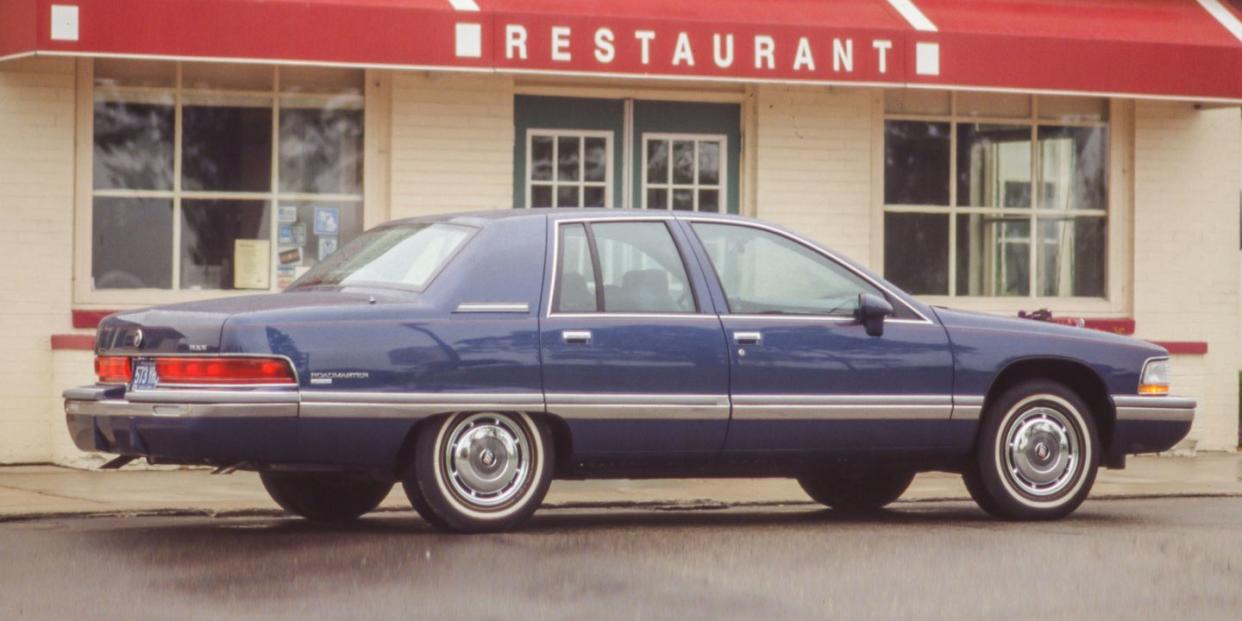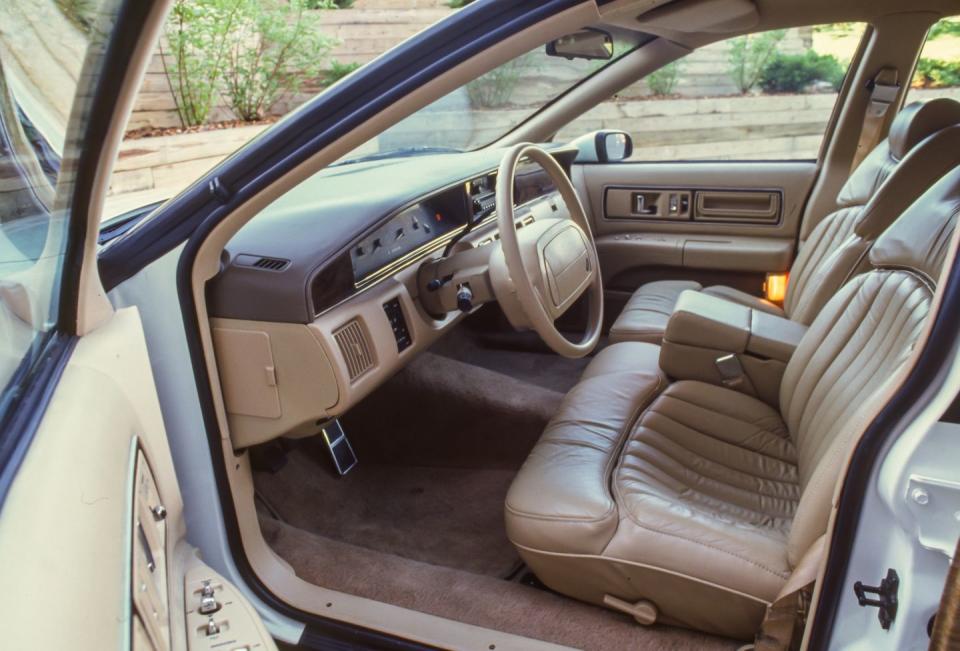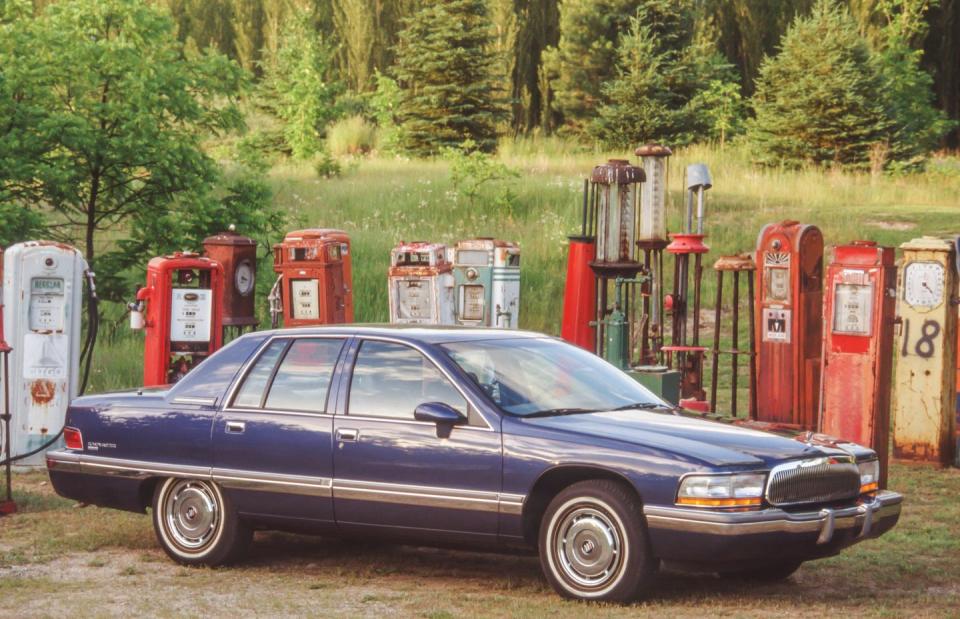Tested: 1994 Buick Roadmaster Gains Real Firepower

From the October 1993 issue of Car and Driver.
The little old lady from Pasadena has a pretty little flower bed of white gardenias,
But parked in a rickety old garage is a brand-new shiny-red super-stock Dodge…
—Jan and Dean, 1964
Had Jan (Berry) and Dean (Torrance) been born 30 years later, their little old lady would not be terrorizing the neighborhood in any super-stock Dodge. Believe it or not, her instrument of terror would be a new 1994 Buick Roadmaster. Just as Granny's sweet little bun of gray hair and pointy-framed glasses mask a maniacal leadfoot soul, so does this Roadmaster's octogenarian skin hide the heart of a beast.
That beast is known in General Motors warehouses everywhere as the LT1. GM seems to be in sync philosophically these days with the exhortation of Her Horniness, Dr. Ruth, who makes a living telling old folks that they need not give up any of the passions of youth. Why else would Buick replace the Roadmaster's old 5.7-liter Barcalounger V-8 engine, as it has, with a version of the hot-rod, pushrod Corvette motor? Holy stewed prunes! Buick has put 260 horsepower and 335 pound-feet of torque under Granny's orthopedic shoe, giving her the opportunity to win the pink slips of the MTV generation as she leaves these hapless youth in a veritable fog of thunderous Uniroyal tire smoke.

This testosteroned Roadmaster can thank its siblings for this transplant. The eighteen-foot-long Cadillac Fleetwood certainly needed a bunch of extra firepower to propel its 4500 pounds. And Chevy's racy new Impala SS model needed a heavy breather to live up to its mag wheels and bold graphics.
Dr. Ruth aside, most Roadmaster owners probably were content with their ten-second zero-to-60-mph times. But in the interest of reducing platform complexity, LT1 engines were made standard across the board. And for those Buick owners who can use a bit of restraint with the accelerator, there is a 1-mpg improvement in EPA city fuel economy, now up to 17 mpg (the highway figure remains 25 mpg).
Corvette obsessives will wonder what happened to the missing 40 horsepower and 5 pound-feet of torque. For starters, the engine has been calibrated to use regular unleaded fuel (simply using premium fuel, as we do with our test cars, increases power and torque by about 1.5 percent). The cam profile has been toned down for a smoother, lower rpm idle at the expense of maximum high-end growl. The intake and exhaust systems are more restrictive, but not because of any space constraints (you could play shuffleboard between the engine and the radiator). Rather, GM simply wanted to hush up things for the luxury-car audience. Finally, Buick's LT1 gets low-cost cast-iron heads instead of the Corvette's lightweight aluminum ones. Minimizing weight on the Roadmaster, it seems, was not a priority.
Stand on the accelerator while pulling out or passing and the distant roar of a Corvette is evident. But the sound is muffled, as if Buick had kidnapped the engine and stuffed it into the Roadmaster's engine bay. Keep your foot to the floor and the mighty LT1 hurtles its burden right up to a tire-rating-limited 108-mph top speed, at which point acceleration is jerked back like a dog that has reached the end of its leash.

At the track, we could only manage a 60-mph time of 7.8 seconds. Forget about brake-torquing—this baby lights up its right rear tire at anything approaching three-quarters throttle. More telling is our impressive quarter-mile trap speed of 90 mph. With better grip, the quarter-mile time might have been reduced from 16.0 seconds to 15.7 or so. By comparison, last year's model ran the quarter in a demure 17.5 seconds at 79 mph.
Traction control, standard on the sibling Fleetwood, is not available on the Roadmaster. Without it, power-on oversteer is a danger on anything slicker than bone-dry asphalt. A limited-slip differential is available for just $100 and should be considered mandatory equipment, if only to ensure even rear tire wear. Still, nothing causes heads to turn and eyebrows to arch in wonderment quite like the sight and sound of a wide-white-walled, chrome-enhanced Buick Roadmaster doing a smoky burnout.

At cruising speed, the driving experience is standard-issue Roadmaster. The famous Dynaride suspension continues unchanged and provides the same ethereal, heavenly cloud ride customers have come to expect. It changes direction and sheds speed only under strenuous protest from those confounding tires. We won't know the full potential of the drivetrain in this platform until we test an Impala SS, whose fat 17-inch tires and suspension tuning are much better suited for the sort of driving we prefer. The 4L60 four-speed automatic transmission gets electronic controls this year (it's a 4L60-E now), but the shift feel is nowhere near as silky and imperceptible as with the transverse 4T60-E.
Inside, the Roadmaster has an all-new instrument panel, redesigned to accommodate a passenger-side airbag and a full-width knee-blocker. The climate controls are above the radio, and both are easily reached without having to lean forward. The minimalist instrument cluster contains just speedo, fuel, and temperature gauge . The four-spoke steering wheel is new, and it features a more compact airbag with a cover that actuates the impressive four-note horn.
Okay, it's overpowered and under-tired, but so what? That super-stock Dodge was, too. Let Dr. Ruth and the Cocoon crowd have their fun. Geritol will never replace the daiquiri. So if you're stopped at a light and hear a four-note blast coming from a little old lady in a Roadmaster next to you, don't do anything silly with your pink slip.
You Might Also Like

 Yahoo News
Yahoo News 
